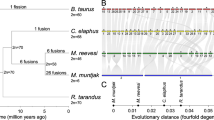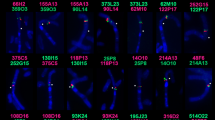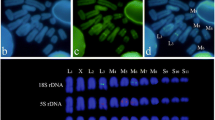Abstract
The (G + C) distribution and the presence and amounts of repetitive sequence families in the white-tailed deer (Odocoileus virginianus) have been examined. The distribution ranges from 20 to 70% (G + C) and shows four distinct repeat families. A 0.7-kb family, DII, corresponds to satellite II in domestic bovids—ox, sheep, and goat—and was singled out for detailed characterization. DII has a prototypic repeat of 67% (G + C), consists of 25,000 tandem copies, and contributes 1.7% to the genomic DNA. Sequencing and electrophoretic analysis indicate a repeat length of 691 bp. These characteristics are similar to those of the bovid satellite II families as well as to those of other cervids that we have examined. The intraspecific sequence divergence within this family has a variance of only 2.5 ± 0.3%.
Similar content being viewed by others
References
Allard MW, Miyamoto MM, Jerecki L, Kraus F, Tennant MR (1992) DNA systematics and evolution of the artiodactyl family bovidea. Proc Natl Acad Sci USA 89:3972–3976
Blake RD, Lefoley SG (1978) Spectral analysis of high-resolution direct-derivative melting curves of DNA for instantaneous and total base composition. Biochim Biophys Acta 518:233–246
Blake RD, Hydorn TG (1985) Spectral analysis for base composition of DNA undergoing melting. J Biochem Biophys Methods 11:307–316
Blake RD (1987) Cooperative lengths of DNA during melting. Biopolymers 26:1063–1074
Bonner T, Brenner D, Neufeld B, Britten R (1973) Reduction in the rate of DNA reassociation by sequence divergence. J Mol Biol 81:123–135
Buckland RA (1983) Comparative structure and evolution of goat and sheep satellite-II DNAs. Nucleic Acids Res 11:1349–1360
Buckland RA (1985). Sequence and evolution of related bovine and caprine satellite DNAs. J Mol Biol 186:25–30
Buckland RA, Elder JK (1985) On the mechanism of amplification of satellite II DNA sequences of the domestic goat Capra hircus. J Mol Biol 186:12–23
Gentry AW, Hooker JJ (1988) The phylogeny of the artiodactyla. In: Benton MJ (ed) The phylogeny and classification of the tetrapods, vol 2. Clarendon Press, Oxford, pp 235–272
Irwin DM, Wilson AC (1990) Concerted evolution of ruminant stomach lysozymes. J Biol Chem 265:4944–4952
Janis CM, Scott KM (1988) The phylogeny of the ruminantia (Artiodactyla, Mammalia). In: Benton MJ (ed) The phylogeny and classification of the tetrapods, vol. 2. Clarendon Press, Oxford, pp 273–282
Maniatis T, Fritsch EF, Sambrook J (1982) Molecular cloning: a laboratory manual. Cold Spring Harbor Laboratory, NY
Miyamoto MM, Goodman M (1986) Biomolecular systematics of eutherian mammals: phylogenetic patterns and classification. Syst Zool 35:230–240
Miyamoto MM, Kraus F, Ryder OA (1990) Phylogeny and evolution of antlered deer determined from mitochondrial DNA sequences. Proc Natl Acad Sci USA 87:6127–6131
Novacek MJ (1982) Information for molecular studies from anatomical and fossil evidence on higher eutherian phylogeny. In: Goodman M (ed) Macromolecular sequences in systematic and evolutionary biology. Plenum Press, NY, pp 3–41
Pearson WR, Lipman DJ (1988) Improved tools for biological sequence comparison. Proc Natl Acad Sci USA 87:6127–6131
Qureshi SA (1990) Characterization of satellite DNAs from selected artiodactyla and their potential as evolutionary clocks. PhD Dissertation, University of Maine
Romer AS (1966) Vertebrate paleontology, 3rd ed. University of Chicago Press, Chicago
Romer R, Riesner D, Courts SM, Maass G (1970) The coupling of conformational transitions in t-RNA from yeast studied by a modified differential absorption technique. Eur J Biochem 15:77–84
Romero-Herrera AE, Lehman H, Joysey KA, Friday AE (1973) Molecular evolution of myoglobin and the fossil record: a phylogenetic synthesis. Nature 246:389–395
Springer MS, Davidson EH, Britten RJ (1992) Calculation of sequence divergence from the thermal stability of DNA heteroduplexes. J Mol Evol 34:379–382
Vizard DL, White RA, Ansevin AT (1984) An analysis of repeated sequence heterogeneity. Arch Biochem Biophys 229:498–508
Wilson AC, Cann RL, Carr SM, George M, Gillensten UB, Helm-Bychowski KM, Higuchi G, Palumbi SR, Prager EM, Sage RD, Stoneking M (1985) Mitochondrial DNA and two perspectives on evolutionary genetics. Biol J Linn Soc 26:375–400
Wilson AC, Ochman H, Prager EM (1987) Molecular time scale for evolution. Trends Genet 3:241–247
Zhang H, Scholl R, Browse J, Somerville C (1988) Double stranded DNA sequencing as a choice for DNA sequencing. Nucleic Acids Res 16:1220
Author information
Authors and Affiliations
Additional information
Present address: ICRP, Room 533, Lincoln's Inn Fields, London WC2A 3PX, England.
Correspondence to: R.D. Blake
Rights and permissions
About this article
Cite this article
Qureshi, S.A., Blake, R.D. Sequence characteristics of a cervid DNA repeat family. J Mol Evol 40, 400–404 (1995). https://doi.org/10.1007/BF00164026
Received:
Issue Date:
DOI: https://doi.org/10.1007/BF00164026




